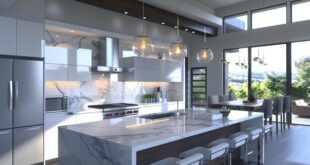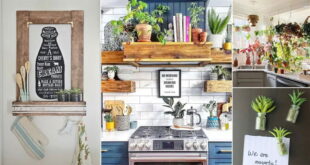Kitchen Flooring: A Foundation for Style and Function
The kitchen. It’s the heart of the home, the gathering place for family and friends, the culinary command center where delicious meals are brought to life. And beneath all the cooking, chatting, and creating lies the foundation – the kitchen floor. Choosing the right kitchen flooring is a big decision, impacting not only the aesthetic appeal but also the practicality and longevity of your space. It’s about finding that perfect balance between style, durability, comfort, and, of course, budget.
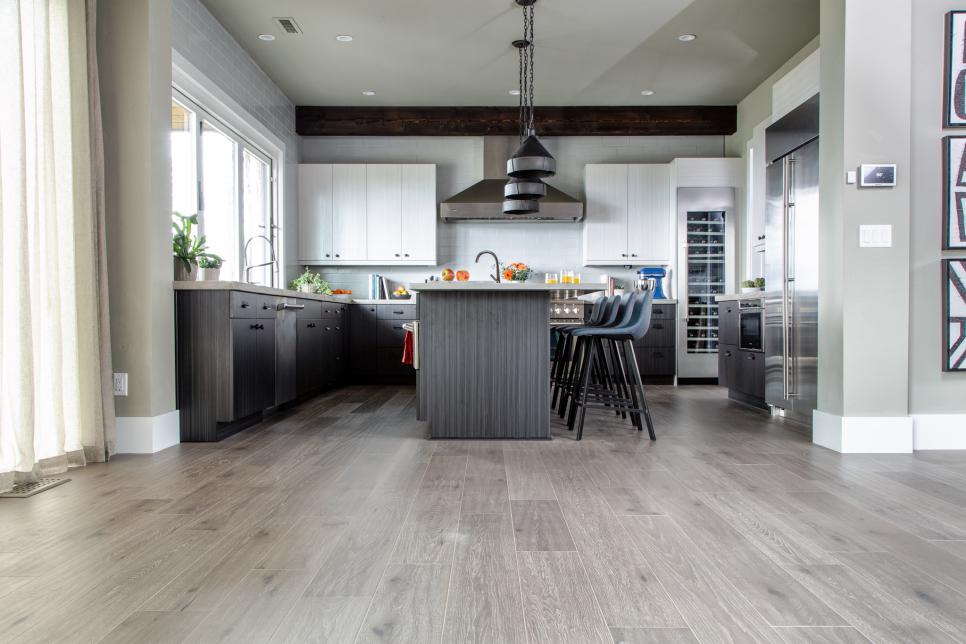
This comprehensive guide dives deep into the world of kitchen flooring, exploring a wide array of materials, styles, and considerations to help you make an informed decision. Whether you’re embarking on a full-scale kitchen remodel or simply looking to refresh your space, we’ll cover everything you need to know to create a kitchen floor that’s both beautiful and built to last.

Understanding Your Kitchen Flooring Needs
Before diving into specific materials, it’s crucial to assess your individual needs and lifestyle. Ask yourself these questions:

- How much traffic does my kitchen see? A busy family with kids and pets will require a more durable and scratch-resistant floor than a single person who rarely cooks.
- What is my budget? Kitchen flooring prices can vary significantly, so it’s essential to set a realistic budget upfront.
- What is my design aesthetic? Do you prefer a modern, minimalist look, a rustic farmhouse vibe, or a classic, timeless style?
- How important is comfort underfoot? If you spend a lot of time cooking, a softer flooring option might be preferable.
- Am I prone to spills? If so, water resistance is a top priority.
- Do I have radiant heat? Certain flooring types are better suited for radiant heat systems than others.
Answering these questions will help you narrow down your options and focus on flooring materials that align with your specific requirements.
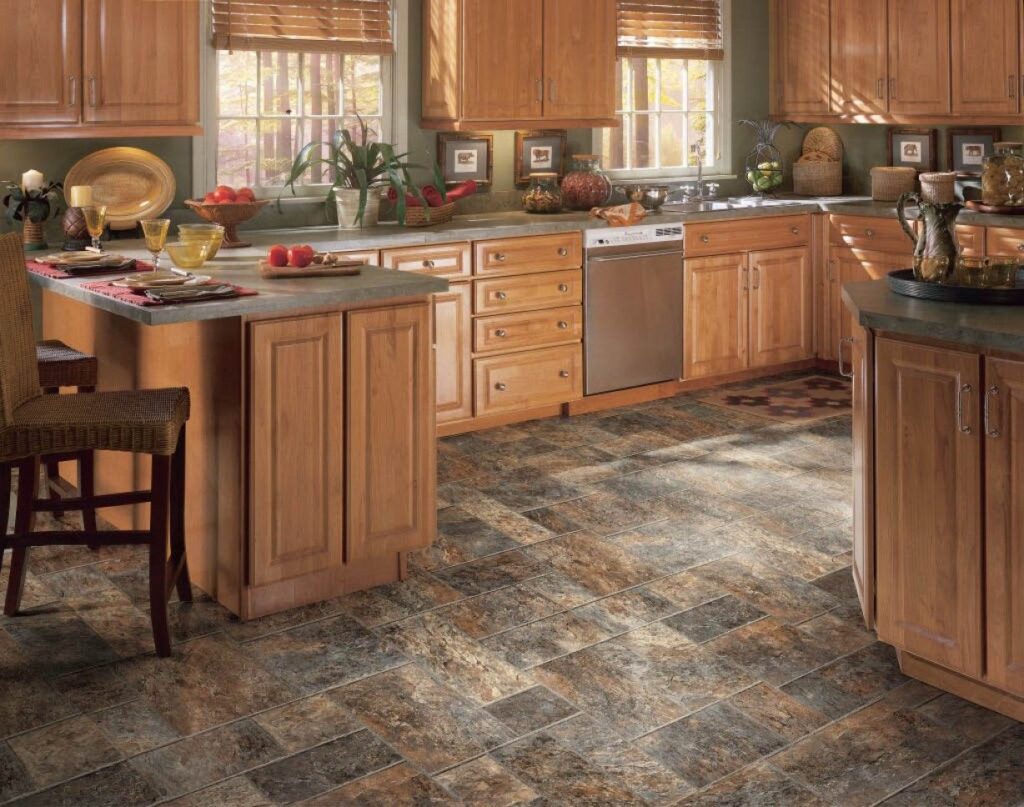
Exploring Popular Kitchen Flooring Materials
The market offers a dizzying array of kitchen flooring options, each with its own set of pros and cons. Let’s explore some of the most popular choices:
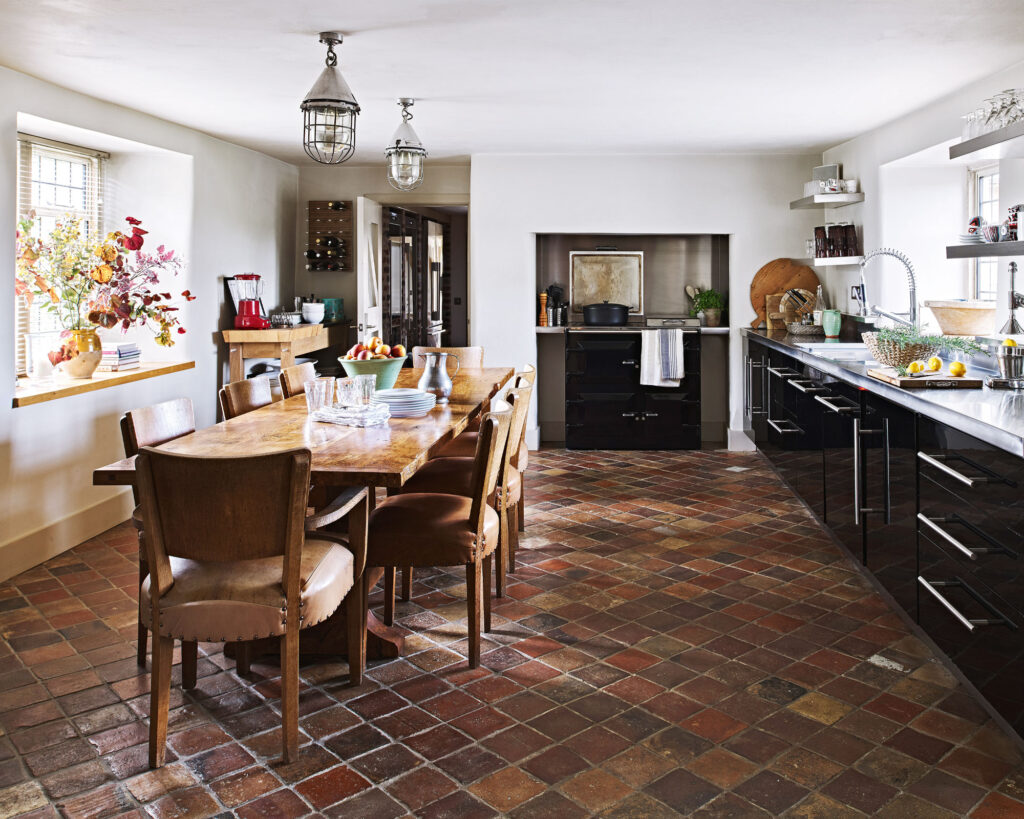
1. Hardwood Flooring: Classic Elegance and Warmth
Hardwood flooring exudes timeless elegance and adds a touch of warmth and sophistication to any kitchen. Its natural beauty and durability have made it a long-standing favorite among homeowners. However, hardwood requires careful consideration in the kitchen environment.
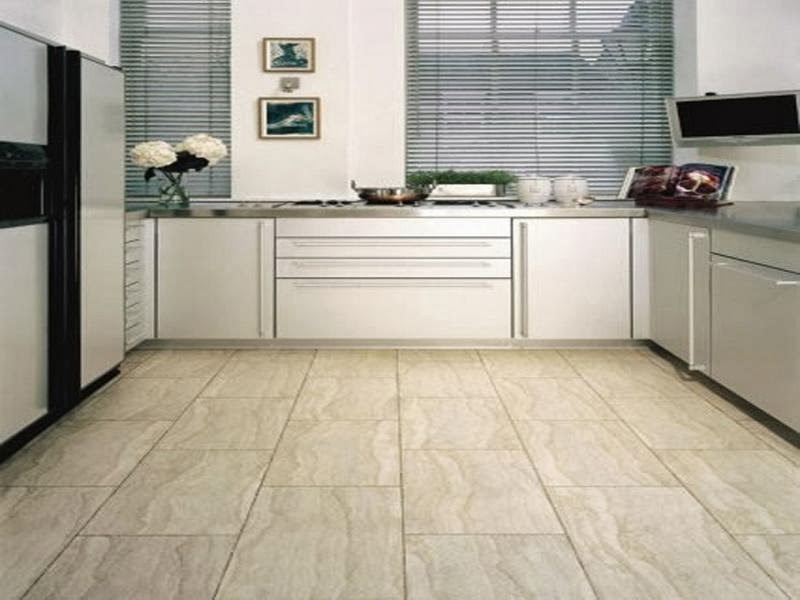
Pros of Hardwood Flooring:
- Timeless Appeal: Hardwood floors never go out of style and can complement a variety of kitchen designs.
- Durability: With proper care, hardwood floors can last for decades, adding value to your home.
- Warmth and Comfort: Hardwood provides a warm and inviting feel underfoot, especially compared to tile or stone.
- Variety: Hardwood comes in a wide range of species, colors, and finishes, allowing you to customize the look of your kitchen. Think oak, maple, hickory, walnut and exotic options like Brazilian Cherry or Bamboo (technically a grass, but often categorized with hardwoods).
- Resale Value: Hardwood floors are generally considered a desirable feature that can increase the resale value of your home.
Cons of Hardwood Flooring:
- Moisture Sensitivity: Hardwood is susceptible to water damage, making it less ideal for kitchens prone to spills or leaks.
- Susceptibility to Scratches and Dents: Hardwood can be scratched by pets or dented by dropped objects.
- Higher Cost: Hardwood flooring is generally more expensive than other options, such as laminate or vinyl.
- Maintenance: Hardwood requires regular cleaning and occasional refinishing to maintain its appearance.
Hardwood Flooring Options for the Kitchen:
- Solid Hardwood: Constructed from a single piece of wood, solid hardwood is the most traditional option.
- Engineered Hardwood: Made from multiple layers of wood veneer, engineered hardwood is more dimensionally stable than solid hardwood and less prone to warping or expanding in humid environments. This makes it a better option for kitchens.
Tips for Hardwood Kitchen Flooring:
- Choose a durable hardwood species, such as oak, maple, or hickory.
- Opt for a water-resistant finish to protect against spills.
- Use rugs in high-traffic areas to prevent scratches and dents.
- Clean up spills immediately to prevent water damage.
2. Tile Flooring: Durable, Versatile, and Stylish
Tile flooring is a popular choice for kitchens due to its durability, water resistance, and wide range of design options. From classic ceramic and porcelain to natural stone and trendy patterns, tile can create a stunning and functional kitchen floor.
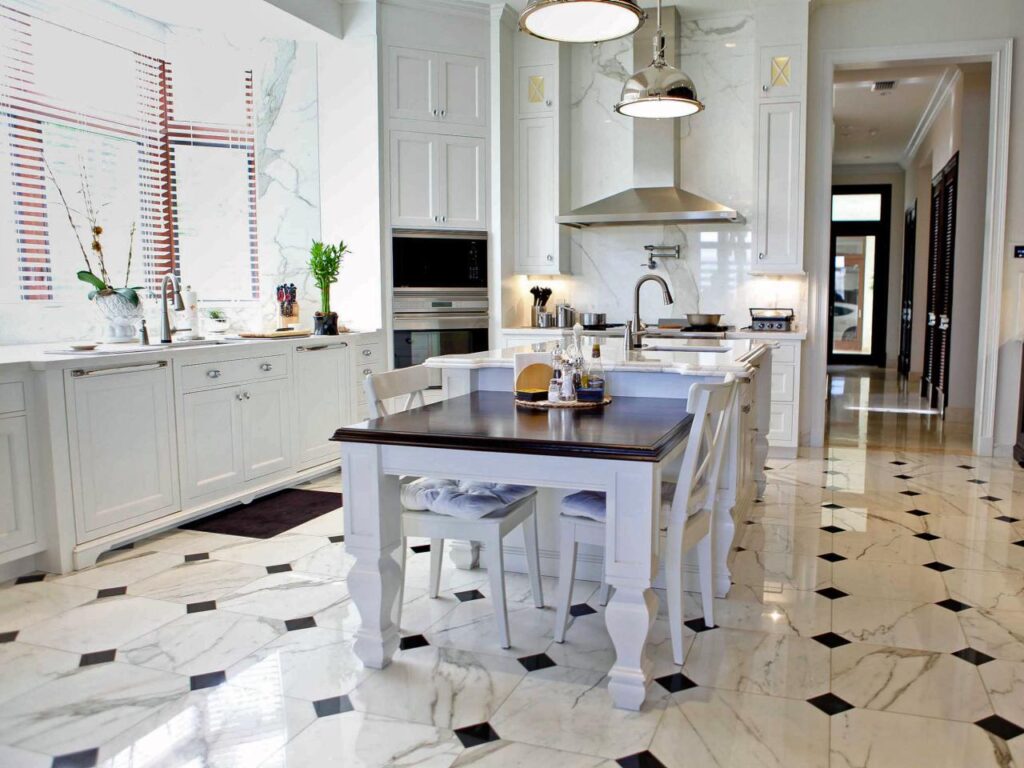
Pros of Tile Flooring:
- Durability: Tile is highly resistant to scratches, stains, and wear, making it ideal for high-traffic kitchens.
- Water Resistance: Tile is waterproof, making it a great choice for kitchens prone to spills and moisture.
- Variety: Tile comes in a vast array of colors, sizes, shapes, and patterns, allowing for endless design possibilities.
- Easy Maintenance: Tile is easy to clean and maintain, requiring only regular sweeping and mopping.
- Resistant to Heat: Tile is a good conductor of heat, making it a great choice if you have radiant floor heating.
Cons of Tile Flooring:
- Hard and Cold: Tile can be hard and cold underfoot, which can be uncomfortable, especially during colder months.
- Grout Maintenance: Grout can be prone to staining and requires regular cleaning and sealing.
- Difficult Installation: Tile installation can be challenging and may require professional assistance.
- Can Be Slippery: Some tile types, especially those with a glossy finish, can be slippery when wet.
- Brittle: While durable, tile can crack if heavy objects are dropped on it.
Types of Tile Flooring for the Kitchen:
- Ceramic Tile: A budget-friendly option that comes in a wide range of styles.
- Porcelain Tile: More durable and water-resistant than ceramic tile, making it a great choice for kitchens.
- Natural Stone Tile: Adds a touch of luxury and natural beauty to any kitchen, but requires more maintenance. Options include slate, granite, travertine, and marble.
Tips for Tile Kitchen Flooring:
- Choose a tile with a textured surface to prevent slipping.
- Use a dark-colored grout to minimize staining.
- Seal the grout regularly to protect it from moisture and stains.
- Consider installing radiant floor heating for added comfort.
3. Laminate Flooring: Affordable and Realistic Wood Look
Laminate flooring is a cost-effective alternative to hardwood flooring that offers a realistic wood-look appearance. It’s made from multiple layers of synthetic materials, including a high-density fiberboard core and a photographic layer that mimics the look of wood or other materials.

Pros of Laminate Flooring:
- Affordability: Laminate flooring is significantly cheaper than hardwood or tile.
- Durability: Laminate is resistant to scratches, stains, and fading, making it a good choice for busy kitchens.
- Easy Installation: Laminate flooring is easy to install, often using a click-lock system.
- Variety: Laminate comes in a wide range of styles and colors, mimicking the look of wood, tile, and stone.
- Easy Maintenance: Laminate flooring is easy to clean and maintain, requiring only regular sweeping and mopping.
Cons of Laminate Flooring:
- Moisture Sensitivity: Laminate is not waterproof and can be damaged by excessive moisture.
- Less Durable Than Hardwood: Laminate is not as durable as hardwood and may need to be replaced sooner.
- Not Repairable: Once damaged, laminate flooring cannot be repaired and must be replaced.
- Can Sound Hollow: Laminate flooring can sometimes sound hollow when walked on.
- Lower Resale Value: Laminate flooring is generally not as desirable as hardwood flooring.
Tips for Laminate Kitchen Flooring:
- Choose a water-resistant laminate flooring specifically designed for kitchens.
- Use a moisture barrier underlayment to protect against moisture.
- Clean up spills immediately to prevent water damage.
- Use rugs in high-traffic areas to prevent scratches.
4. Vinyl Flooring: Waterproof and Versatile
Vinyl flooring is a synthetic flooring option that is known for its water resistance, durability, and versatility. It’s available in a variety of forms, including sheet vinyl, vinyl tile, and luxury vinyl plank (LVP).
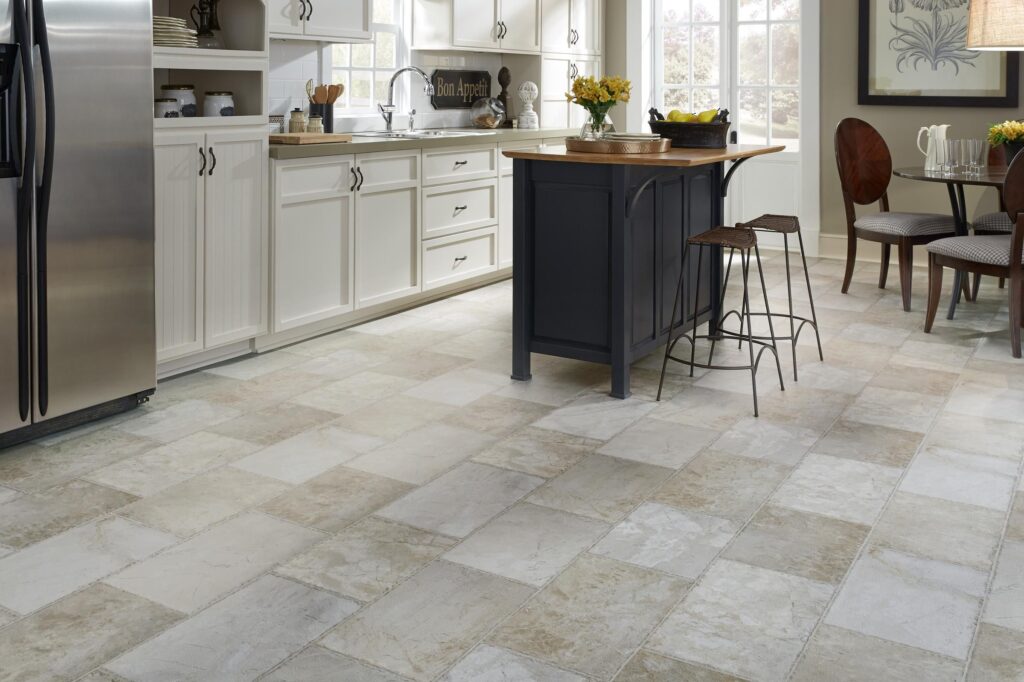
Pros of Vinyl Flooring:
- Waterproof: Vinyl is completely waterproof, making it an ideal choice for kitchens prone to spills and moisture.
- Durability: Vinyl is resistant to scratches, stains, and wear, making it a good choice for high-traffic kitchens.
- Affordability: Vinyl flooring is generally more affordable than hardwood or tile.
- Variety: Vinyl comes in a wide range of styles and colors, mimicking the look of wood, tile, and stone.
- Easy Installation: Vinyl flooring is relatively easy to install, especially LVP with click-lock systems.
- Comfort Underfoot: Vinyl is softer and warmer underfoot than tile or stone.
Cons of Vinyl Flooring:
- Can Be Dented: Vinyl can be dented by heavy objects or furniture.
- Difficult to Repair: Once damaged, vinyl flooring can be difficult to repair.
- Can Fade Over Time: Some vinyl flooring can fade over time when exposed to direct sunlight.
- Lower Resale Value: Vinyl flooring is generally not as desirable as hardwood or tile.
- Chemical Off-Gassing: Some vinyl products may release volatile organic compounds (VOCs). Look for low-VOC options.
Types of Vinyl Flooring for the Kitchen:
- Sheet Vinyl: Comes in large rolls and offers a seamless, waterproof surface.
- Vinyl Tile: Individual tiles that can be installed in various patterns.
- Luxury Vinyl Plank (LVP): Mimics the look of hardwood planks and offers greater durability and water resistance.
Tips for Vinyl Kitchen Flooring:
- Choose a high-quality vinyl flooring with a thick wear layer for added durability.
- Look for low-VOC vinyl flooring options.
- Use rugs in high-traffic areas to prevent dents.
5. Concrete Flooring: Modern and Industrial Chic
Concrete flooring is a popular choice for modern and industrial-style kitchens. Its minimalist aesthetic, durability, and versatility make it a unique and stylish option.

Pros of Concrete Flooring:
- Durability: Concrete is extremely durable and can withstand heavy traffic and wear.
- Versatility: Concrete can be stained, polished, or stamped to create a variety of looks.
- Low Maintenance: Concrete flooring requires minimal maintenance.
- Thermal Mass: Concrete can absorb and retain heat, making it energy-efficient.
- Unique Aesthetic: Concrete provides a unique and modern aesthetic.
Cons of Concrete Flooring:
- Hard and Cold: Concrete can be hard and cold underfoot, especially during colder months.
- Porous: Concrete is porous and can stain if not properly sealed.
- Cracking: Concrete can crack over time due to settling or temperature changes.
- Difficult Installation: Concrete installation can be challenging and may require professional assistance.
- Can Be Expensive: Polished and stained concrete can be expensive to install.
Tips for Concrete Kitchen Flooring:
- Seal the concrete properly to protect it from stains and moisture.
- Consider installing radiant floor heating for added comfort.
- Use rugs in high-traffic areas to add warmth and comfort.
6. Other Kitchen Flooring Options
While the above materials are the most popular, there are other, less common kitchen flooring ideas to consider:
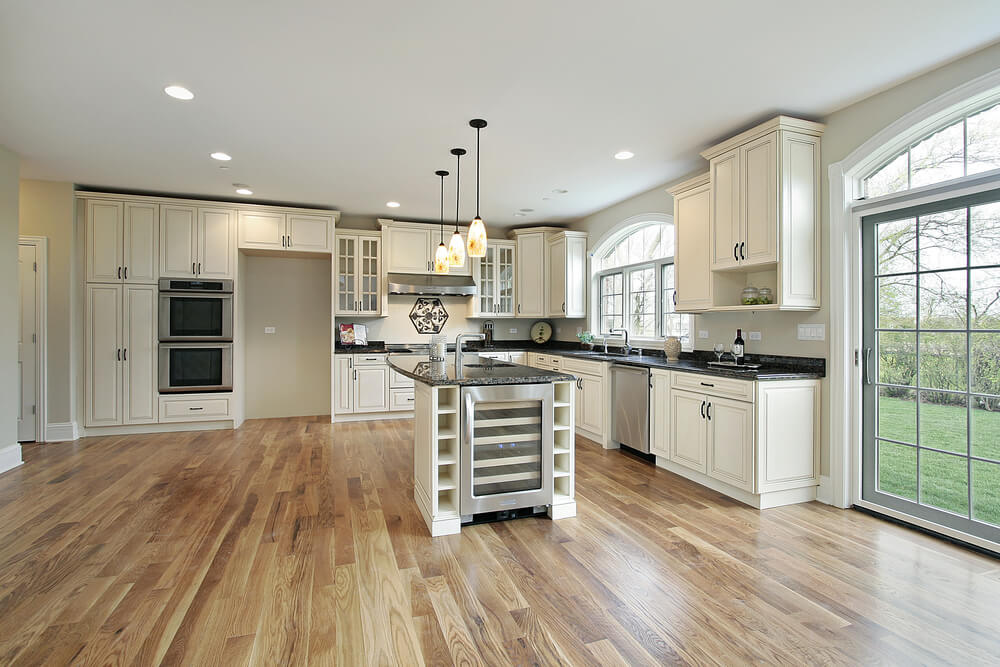
- Bamboo Flooring: A sustainable and eco-friendly option that is durable and water-resistant. However, not all bamboo is created equal. Strand-woven bamboo is the hardest and most durable.
- Cork Flooring: A soft and comfortable option that is also eco-friendly and naturally antimicrobial. It’s surprisingly water-resistant when properly sealed.
- Linoleum Flooring: A natural and sustainable option that is durable and water-resistant. Don’t confuse it with vinyl – linoleum is made from linseed oil, cork dust, wood flour, and other natural materials.
- Rubber Flooring: A durable and slip-resistant option that is often used in commercial kitchens. It’s comfortable underfoot and comes in various colors and patterns.
Design Considerations for Kitchen Flooring
Beyond the material itself, consider these design elements when selecting your kitchen flooring:

- Color: Light colors can make a small kitchen feel larger and brighter, while dark colors can add warmth and sophistication.
- Pattern: Patterns can add visual interest to your kitchen floor. Consider patterns like herringbone, chevron, or basketweave.
- Texture: Textured flooring can add depth and dimension to your kitchen.
- Size: Larger tiles can make a small kitchen feel larger, while smaller tiles can add detail and visual interest.
- Grout Color: The grout color can significantly impact the overall look of your tile floor. Consider using a contrasting grout color to highlight the tile pattern or a matching grout color for a more seamless look.
Installation and Maintenance
Proper installation and maintenance are crucial for ensuring the longevity and beauty of your kitchen floor. Some flooring types, such as laminate and LVP, are relatively easy to install yourself, while others, such as tile and hardwood, may require professional installation. Regardless of the flooring type you choose, be sure to follow the manufacturer’s instructions carefully.
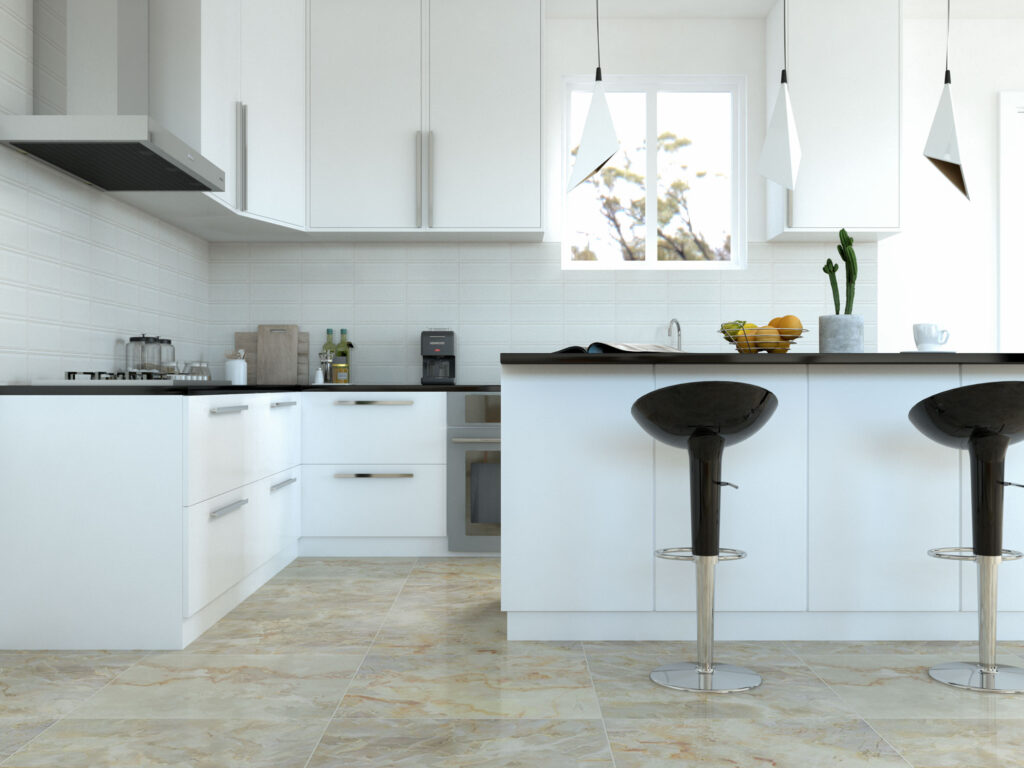
Regular cleaning and maintenance are also essential. Sweep or vacuum your kitchen floor regularly to remove dirt and debris. Clean spills immediately to prevent staining or damage. Use a pH-neutral cleaner specifically designed for your flooring type. Avoid using harsh chemicals or abrasive cleaners, as they can damage the finish.
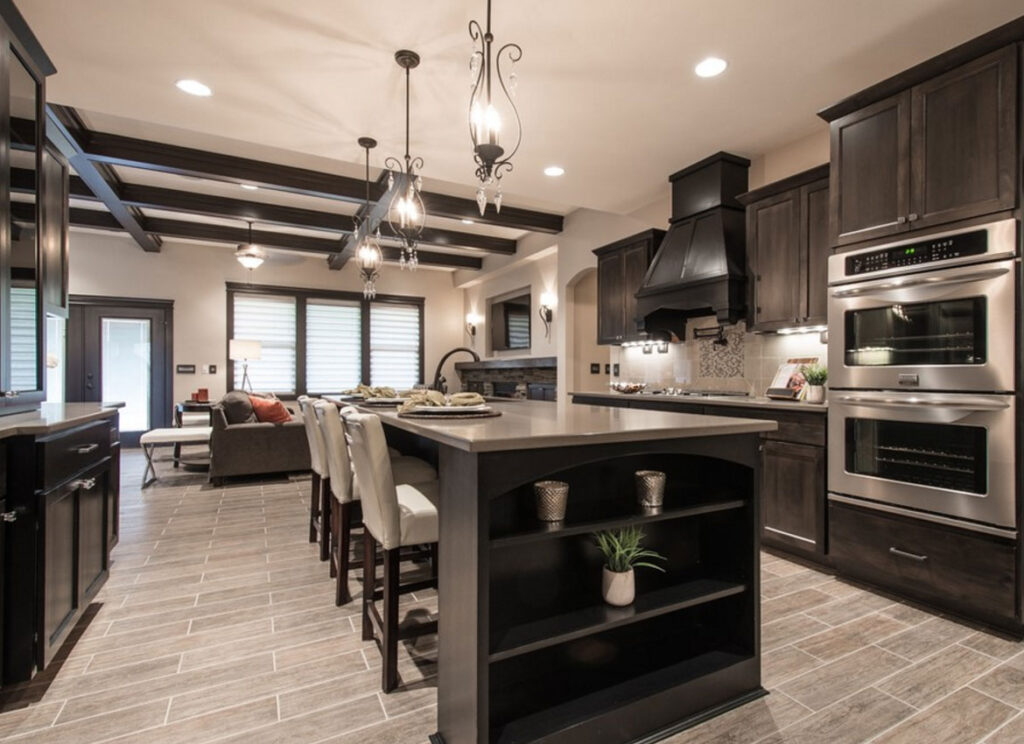
Budgeting for Kitchen Flooring
The cost of kitchen flooring can vary significantly depending on the material, installation costs, and other factors. Set a realistic budget upfront and get quotes from multiple contractors before making a decision. Be sure to factor in the cost of underlayment, adhesives, grout, and other necessary materials.
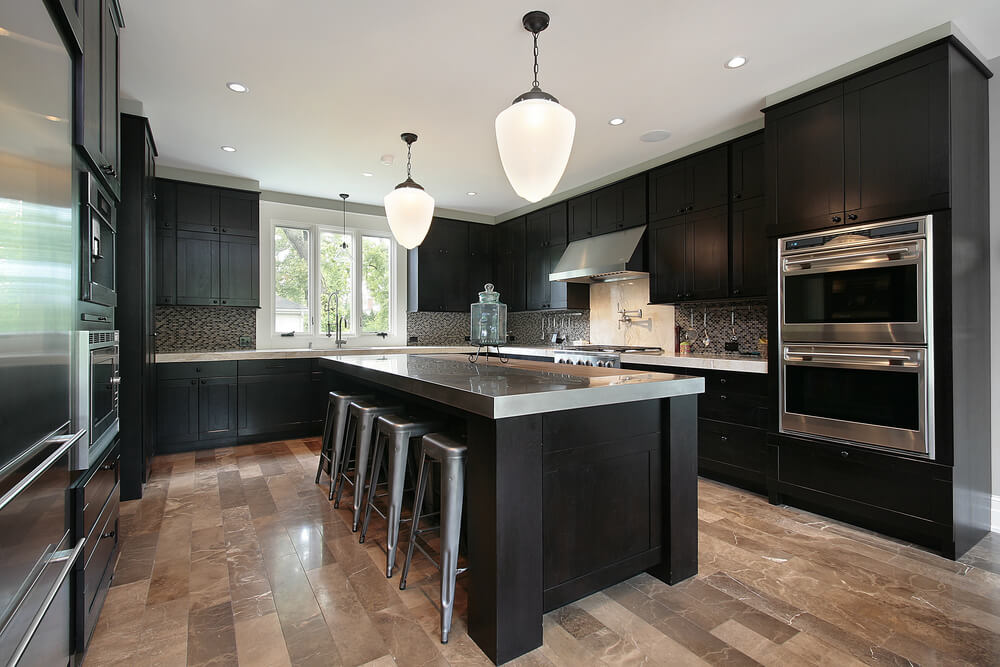
Consider the long-term value of your investment. While some flooring options may be cheaper upfront, they may not last as long or add as much value to your home as more expensive options.
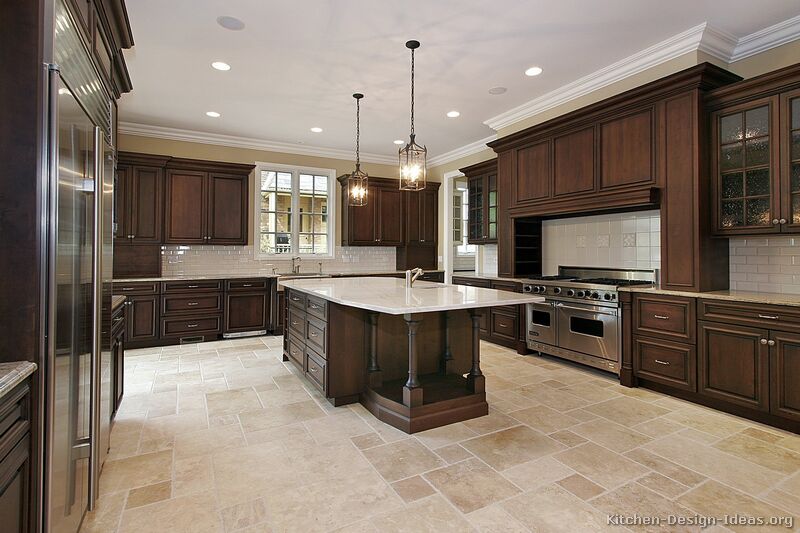
Conclusion: Choosing the Right Kitchen Flooring for You
Selecting the right kitchen flooring is a crucial decision that impacts both the aesthetic appeal and functionality of your space. By carefully considering your needs, budget, and design preferences, you can choose a flooring material that is both beautiful and built to last. Weigh the pros and cons of each material, paying close attention to durability, water resistance, maintenance requirements, and style compatibility. With a little research and planning, you can create a kitchen floor that you’ll love for years to come – a foundation for countless meals, memories, and moments in the heart of your home.

 Nimila
Nimila



